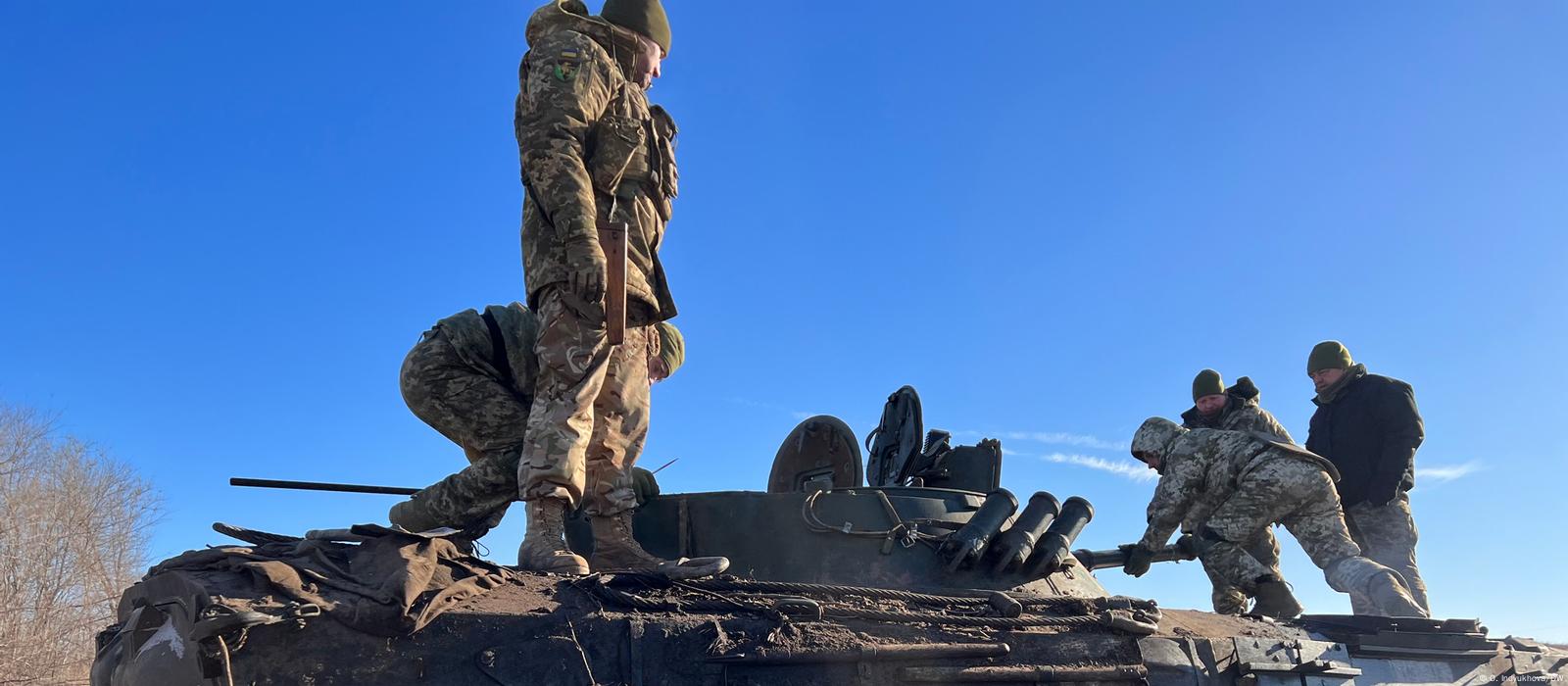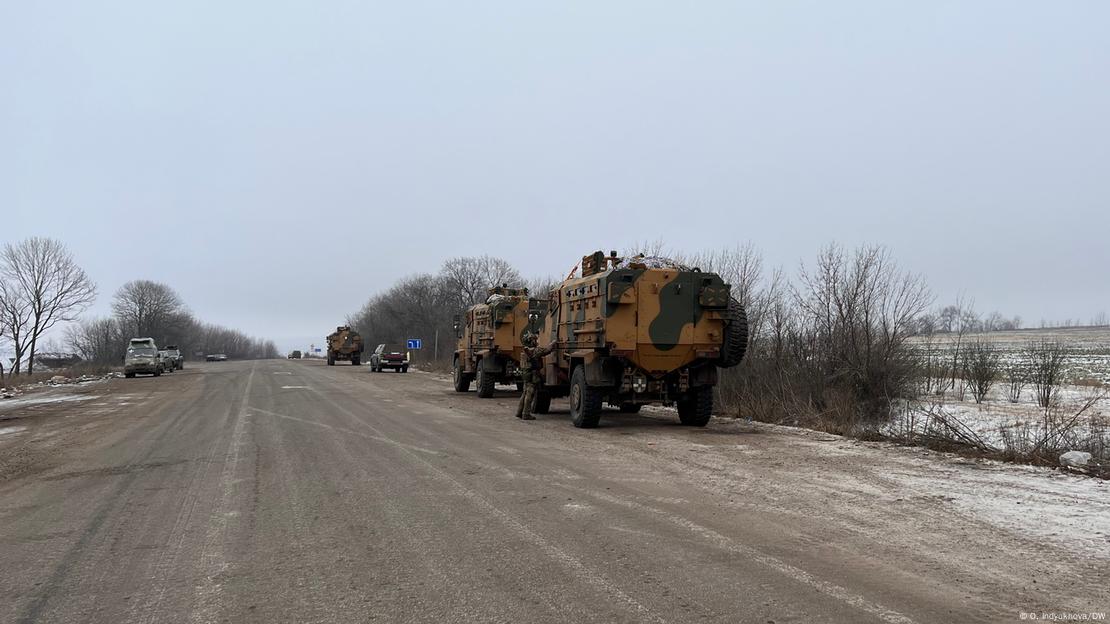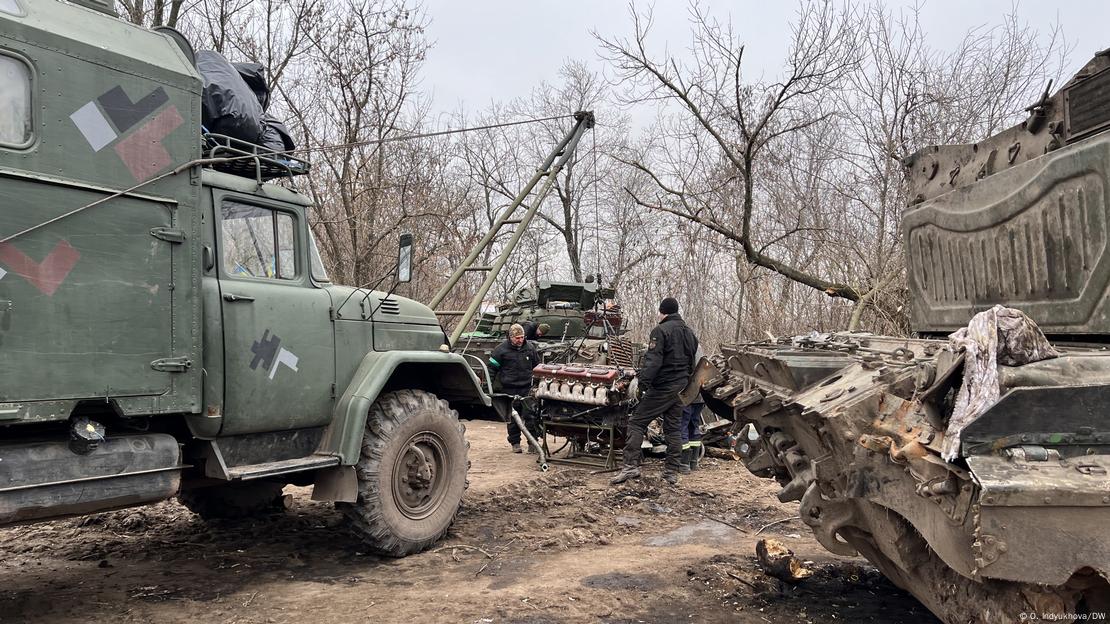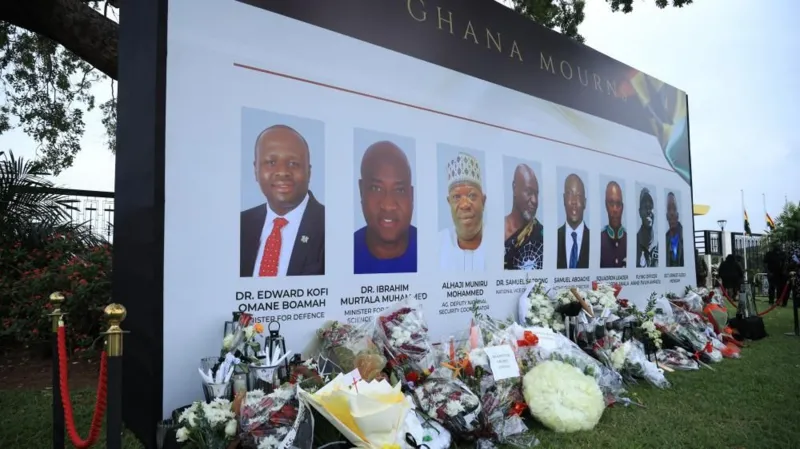Ukrainian tank unit fights Russians, exhaustion and the cold
Members of a Ukrainian armored unit fighting near Bakhmut describe the horrific situation at the frontline. They also explained why they need modern Western equipment.

A freezing wind swept across the steppe near Donetsk in eastern Ukraine. The thermometer showed minus 17 degrees Celsius (1.4 degrees Fahrenheit). The frontline of the war against Russia, where fighting is taking place for the towns of Bakhmut and Soledar, is just a few kilometers away.
Soldiers from a Ukrainian tank unit were training here in the middle of a field, just a few days after being pulled from the fighting near Bakhmut for a short break. To reach the spot, they had to walk several kilometers crosscountry.
"So, is it hard to walk in a bulletproof vest? Are your arms and legs freezing yet?" asked Ihor, an officer in the armored unit, who accompanied DW to where the troops was deployed. "Imagine the guys lying in the frozen trenches, where you're not even allowed to light stoves so their positions aren't betrayed," he said.
DW spoke to the soldiers here during a break. Like Ihor, they did not want to give their full names and not everyone wanted their picture taken. Some have relatives in areas occupied by the Russians. In some cases, their families didn't even know they were on the frontline.
'They have such huge losses'
According to the officers of this armored unit, the balance of forces in the area is currently about 10 Russian soldiers to one Ukrainian one. Along this section of the front, the Ukrainian soldiers are mainly facing members of the Wagner Group, a private force that has recently been recruiting inmates from Russian prisons.
At Bakhmut and Soledar, Russian and Ukrainian forces' positions are very close together, said Oleh, one of the commanders. Time and again, the soldiers are engaged in hand-to-hand combat, he said. "We can even hear the enemy commanders' orders."

Like everyone here, Ihor, a 40-something infantryman, was clearly exhausted. "The Ukrainian military is fighting at the very limits of human strength," he said, adding they have no chance to sleep. They are under fire, day and night, continuously attacked by the Russian infantry.
Small groups of 10 to 15 Russian soldiers move "in waves" towards the Ukrainian positions, right into the crossfire from the Ukrainian trenches, said another officer.
"We shoot, they die — there are piles of bodies on the field. Then the next group comes," the officer said. "They don't even help their wounded, they just keep moving toward us.
"It's hard to bear this, but we have no choice," said his comrade Dmytro. "I want and need to defend my country, my family, so that we have a future."
The legacy of Soviet weapons
Ukrainian forces need more equipment and weapons — preferably of non-Soviet design — to continue their counteroffensive and to liberate more occupied territory, the unit's commanders say.

The unit's engineers lead DW to a couple of Soviet T-72 tanks in need of repair after the fighting. Out in the field, there are tool boxes and generators. A truck with a crane pulls the engine block out of one of the tanks.
The engine stopped once during battle, but "miraculously, the mechanic restarted it and the crew was able to save themselves," an engineer named Andriy recalled. "You see this hole in the engine? It's been shot," he added.
The mechanics replaced the old block with a new engine. The description "new" is relative though. All spare parts for the T-72 were made in Russia and Ukraine stopped buying them a long time ago. "We still have spare parts in stock. But some things are missing. Then we cannibalize our damaged or captured Russian tanks," Andriy said.
The Ukrainian army should get rid of its legacy Soviet tanks, in fact all Soviet equipment, he said, arguing that it can't compare with modern equipment and that it hardly protects the troops. Deputy birgade commander Konstantin agreed. The Russian army can only be defeated with modern technology, he said, and the Ukrainian military needs Western weapons and equipment.
Waiting for Leopard 2 to arrive
The soldiers would like new tanks because they "want to complete the liberation of Ukrainian territory as soon as possible," the commanders told DW.
The soldiers here talked about the potential of the German Leopard tanks and what they might do, as well as the armored infantry fighting vehicles — the German Marder and the American Bradley — promised by Western partners. They also discussed the debate in Germany about the delivery of the tanks. On Wednesday, Germany said it would send 14 Leopard 2 tanks to Ukraine and all the re-export of the German-made battle tanks from other countries that wish to send them to Ukraine.
"The Leopard is what we need right now — the high-precision sights and night vision work in any weather," Konstantin said, adding that above all, "the Russians are afraid of the Leopard."
Meanwhile, Serhiy was busy welding a radiator that was more than 50 years old. The mechanic has been in the army since 2014, his hands bruised from the job.
"The Ukrainian armed forces need Western equipment, preferably with spare parts and logistics for repairs," he said. Serhiy is convinced he can repair Western equipment too, suggesting that the engines are not so different.
"The main thing is that I know how to get everything running again," he said.
Under pressure, Serhiy and his team have repaired several tanks, infantry fighting vehicles and trucks here. Combat at Bakhmut and Soledar is increasingly fierce, so that even the engineers hardly get any sleep. They say they must "stand firm."
"This war is terrible," Ihor said. But there is no other option for him and his comrades. "We have to win so we can continue to live in freedom," he concluded.
This article was originally written in Russian.
Source - DW







